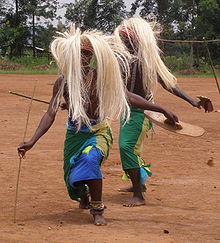


Traditional intore dancers in Rwanda
| |
| Genre | Traditional dance |
|---|---|
| Instrument(s) | Drums, lulunga |
| Origin | Rwanda |
Intore, sometimes called the Dance of Heroes,[1] is a traditional dance performed by men in Rwanda; women are not allowed to do so.[2]
In pre-colonial times, intore was a war dance performed by the Tutsi military.[3] Dance numbers were often war-themed, and the performing men carried actual weapons. Present-day intore dancers do not carry actual weapons, but instead use replicas.[4] It is now performed at various celebrations and public ceremonies, including family gatherings and Rwandan national events.[5] The dance is accompanied by drum ensemble (from seven to nine drums), providing strong, almost hypnotic set of rhythms. Melodic interludes are provided by the lulunga, a harp-like instrument with eight strings.[6]
Potential dancers are chosen based on physical and moral attributes. Before they can perform, the intore dancers receive training, where they learn the steps of the dance as well as moral values.[7]
This Rwanda-related article is a stub. You can help Wikipedia by expanding it. |